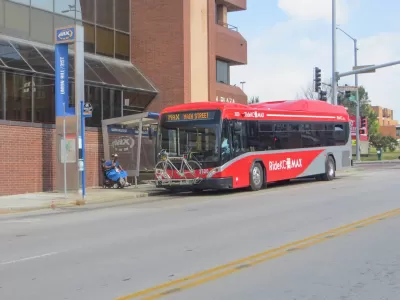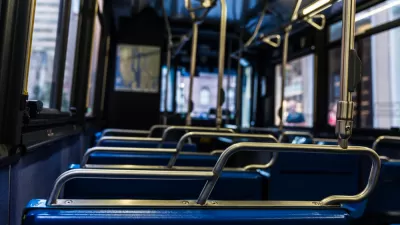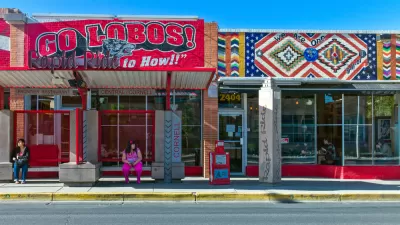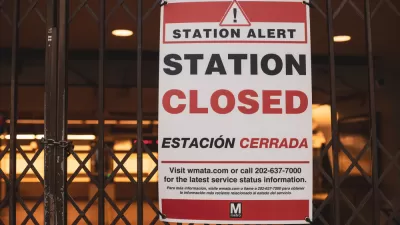Opinion: The movement toward fare-free transit might have more to do with optics and politics than planning.

Washington, D.C. is the latest U.S. city to eliminate fares for public transit riders, after a vote by the D.C. Council on December 6. Connecticut, Seattle, Atlanta, Boulder, and Tucson are among the locations that have extended, implemented, or explored forms of fare-free transit programs in the second half of the calendar year. They follow a host of agencies that launched fare-free transit during the pandemic.
While more evidence of the ridership benefits of fare-free transit emerges along with these new programs (a statewide fare-free program in Colorado boosted ridership during the summer months, for example), it’s a good time for a regularly scheduled reminder that free transit often comes at the cost of improved transit service.
At some point during the pandemic, the transit planning trend du jour became eliminating fares for some or all ridership groups—such programmatic changes far outpacing other potential transit improvements, such as improved stop facilities, protected bus lanes or other street reconfigurations, and increased service levels. It's unclear when the field of planning decided that fare-free transit was the best route to transit success, but that’s the way we are headed.
There are certainly reasons to pause before smashing the fare-free button. Jerusalem Demsas, for example, makes that argument in a recent (paywalled) article for the Atlantic titled “Buses Shouldn’t Be Free.”
Fare-free transit sounds great in theory, but American bus networks are far behind global leaders in offering good service. Focusing on zero-dollar rides is like overseeing a library system stocked solely with out-of-date self-help books in crumbling buildings and wondering if a fresh coat of paint will improve morale.
An article by Peggy Lowe, Ian Duncan, and Justin George for the Washington Post shares the opinions of bus riders around the Washington, D.C. area who admit the savings on fares are appreciated, but perhaps more appreciated would be buses that come more often and get to where there going faster and more efficiently.
While [Tammy] Ward said she likes the financial savings of the free ridership plan, she wishes she could count on the bus to get her to work on time or across the city for shopping or visiting relatives.
The arguments in these two articles are not new—though there are new case studies of agencies and jurisdictions not heeding their warnings. Jarret Walker, one of the nation’s leading consultant on service design and system redesign, has argued a preference for system improvements over fare-free programs, most recently making the Planetizen news feed for this view in 2021. Steven Polzin explained the fiscal impacts of fare reduction programs in a tour de force blog post in 2018.
Washington, D.C. is now the most populous city with fare-free transit in the country (ahead of Kansas City, and Los Angeles’s fare-free transit is currently defunct), and the Washington Post article implies that D.C.’s new program could influence other cities to follow suit.
The remaining question: What’s more beneficial to transit riders—reduced fares or improved transit? It’s important to ask these kinds of questions, but it’s unclear if many cities are. In fact—it’s reasonable to suspect that the reason fare-free transit is so popular is that it avoids hard conversations with the dominant political power when it comes to the use of the public realm in these cities—car drivers. Fare-free transit is happening “behind closed doors”—out of view of the car drivers rushing past as bus riders line up to get onto buses. New bumpouts, protected bus lanes, or signal prioritization—the tools of improved transit service—are much more conspicuous and much more likely to provoke the ire of a gadfly or even a politician.
While there is a good argument to be made for fare-free transit as a tool of equity—especially after seeing transit ridership patters shift to essential workers and low-income communities during and after the pandemic—some of the advocates and sources contributing to these articles in Planetizen, the Washington Post, and the Atlantic are suggesting that equity would be better served by better service.
Like so many other issues, and especially questions of equity, the answer are not as convenient as we might hope.

Study: Maui’s Plan to Convert Vacation Rentals to Long-Term Housing Could Cause Nearly $1 Billion Economic Loss
The plan would reduce visitor accommodation by 25,% resulting in 1,900 jobs lost.

North Texas Transit Leaders Tout Benefits of TOD for Growing Region
At a summit focused on transit-oriented development, policymakers discussed how North Texas’ expanded light rail system can serve as a tool for economic growth.

Why Should We Subsidize Public Transportation?
Many public transit agencies face financial stress due to rising costs, declining fare revenue, and declining subsidies. Transit advocates must provide a strong business case for increasing public transit funding.

How to Make US Trains Faster
Changes to boarding platforms and a switch to electric trains could improve U.S. passenger rail service without the added cost of high-speed rail.

Columbia’s Revitalized ‘Loop’ Is a Hub for Local Entrepreneurs
A focus on small businesses is helping a commercial corridor in Columbia, Missouri thrive.

Invasive Insect Threatens Minnesota’s Ash Forests
The Emerald Ash Borer is a rapidly spreading invasive pest threatening Minnesota’s ash trees, and homeowners are encouraged to plant diverse replacement species, avoid moving ash firewood, and monitor for signs of infestation.
Urban Design for Planners 1: Software Tools
This six-course series explores essential urban design concepts using open source software and equips planners with the tools they need to participate fully in the urban design process.
Planning for Universal Design
Learn the tools for implementing Universal Design in planning regulations.
City of Santa Clarita
Ascent Environmental
Institute for Housing and Urban Development Studies (IHS)
City of Grandview
Harvard GSD Executive Education
Toledo-Lucas County Plan Commissions
Salt Lake City
NYU Wagner Graduate School of Public Service






























